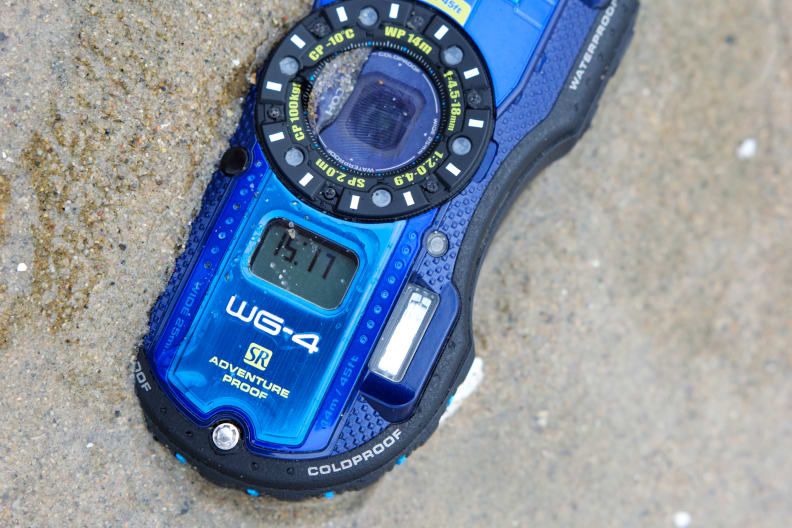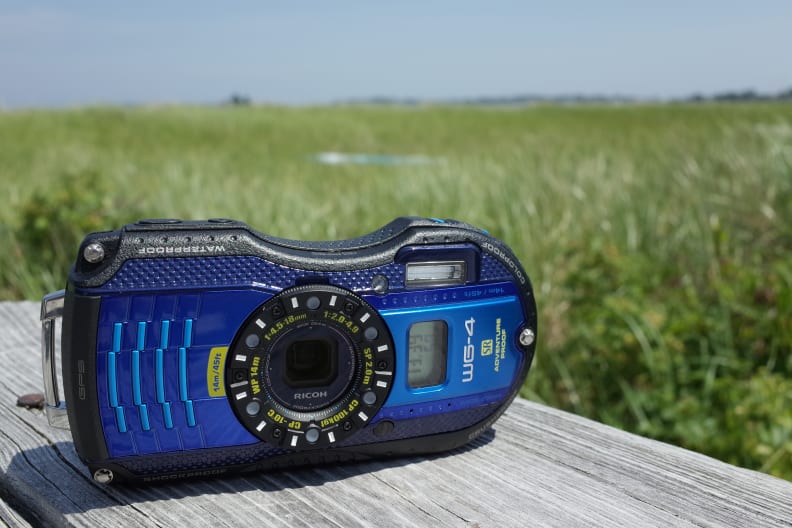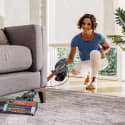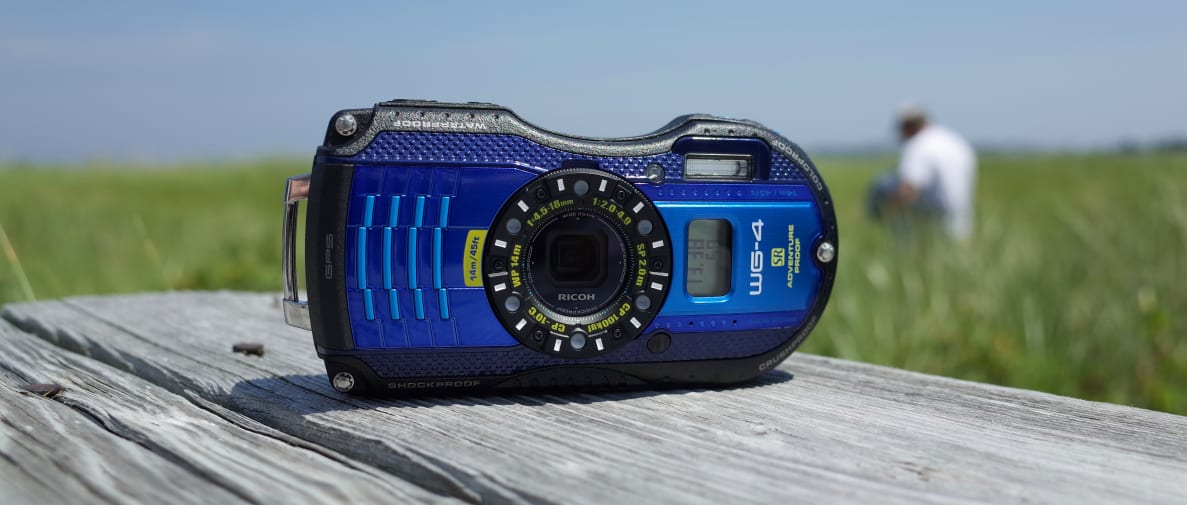Rather than pull a complete re-do, Ricoh decided to leave well enough alone with the WG-4 (MSRP $379.99). While we were hoping for some nice improvements, we came away wishing that this camera were a bit better in most aspects. That said, it still has some unique features that most other waterproof cameras don't—helping the WG-4 live up to its self-appointed "adventure-proof" status.
You get a very similar body, with or without GPS, with the GPS version rocking a nice secondary LCD on the front of the camera. A 16-megapixel sensor with a 4x zoom lens and an f/2.0-4.9 maximum aperture are carried over with little change from last year. We're doubting that Ricoh will make a name for itself this year with a warmed-over toughcam, but can this awkwardly styled little camera still hang ten with the rest of the 2014 waterproof pack?

Design & Handling
Here we go again
If there's one thing we can say about Ricoh's waterproof cameras, it's that they've never looked…ordinary. The WG-4 continues that tradition by only very slightly iterating on the WG-3's design, which we still think looks like a cavalcade of mismatched design elements.
We think it was a wise move to offer the WG-4 in more subtle color combinations, eschewing the army green, purple, and orange of last year's model for more mature silver, dark blue, and black schemes. If those color options are too subtle for you (or you want high visibility), Ricoh is still offering a screaming lime yellow, too.
{{ photo_gallery "tour" }}
The WG-4 is an all-plastic affair with decent ergonomics and a mix of rubberized and painted, glossy surfaces. We wish that the camera's body were easier to hold onto—as it stands, we'd definitely want a secure wrist strap if heading into the ocean with the WG-4.
One trope that remains exactly the same as last year's WG is the overabundance of stats and figures printed all over the camera's body. The front and back are positively covered in 45 ft this and f/2.0 that. It all centers around the camera's lens, where branding, specs, and exposed screws crescendo to new heights of tackiness. Other then the front lens element, the only useful part of the front cluster is a batch of LEDs, incredibly useful for illuminating macro subjects. Questionable aesthetics aside, the WG-4 feels as tough as it is. There's not an ounce of flex in the body, with a rigidness that separates it from its similar, cheaper sibling, the WG-20.
On the front of the device is a backlit black and white LCD screen that displays the time and altitude. It's a nice feature that even works when the camera is off. This is only available on the GPS-enabled model of this camera, which is a bit more expensive than the regular flavor. The rear LCD screen is bright as long as you pump up the brightness manually. Coming in at 460k dots, this display isn't the sharpest, but its hard plastic covering feels tough-as-nails.
{{ photo_gallery "design" }}
The WG-4's buttons are all well-suited for shooting. Every one gives a nice bit of positive feedback, letting your fingers know that you've successfully pressed it. While the controls on the back of the WG-4 are raised, the power and shutter buttons are both fairly flush with the top surface of the camera. This is good for the power button, but less good for the shutter button. As it stands, it's a bit gummy and it can be tough to tell when you've got focus locked in.
Features
Honestly, this section could be from the WG-3 review.
In the crowded tough camera segment, the WG-4 manages to stick out with a couple very special features that some of the competition doesn't come with. As cool as some of these tricks are, there are also a couple of major issues that you should be aware of.
While WiFi isn't an option this year, the top-tier version has GPS for location tagging. You won't find Qi wireless charging in the WG-4, which was an innovative feature in last year's model. While most users probably never even tried this feature out, it's always disappointing to see uniqueness hit the chopping block in the name of cost-cutting.
Inside, you get the same stabilized 16-megapixel, backside illuminated CMOS sensor. That's topped off with 4x optical zoom, which is just enough to differentiate this from a smartphone camera. It's not the sharpest lens, however, and Ricoh's processing isn't as aggressive in enhancing details as, say, the Olympus TG-3, which has very nearly the same lens.
Really, though, the lack of WiFi is almost inexcusable at this price point. Let's say you've just gotten the camera wet in a pool, but you want to share photos of your kids to their grandparents. You can't without buying some other accessory like an EyeFi card. Ricoh could have thrown users a bone and added compatibility with a Flucard, like on the Ricoh-made Pentax K-3 DSLR—at least that solution also lets you remotely control the camera with your smartphone.

Barnacles! Digital microscope mode is great fun.
We love the WG-4's digital microscope setting, however, which uses a ring of LEDs around the lens to take macro photographs. It works really well, and, unlike some competing cameras, it's not an extra add-on. The minimum focusing distance is around a centimeter, meaning you can just about press the camera against the object you want to photograph. The results are excellent.
Corny though it may sound, the inclusion of a digital compass, along with a clock and an altimeter, is actually pretty neat. You can track your depth while diving, or, inversely, your altitude when in the mountains. We'd recommend springing for the slightly more expensive version with GPS just to get these quirky-but-thoughtful additions to this toughcam.

The WG-4's most interesting feature is probably its backlit clock/altimeter (only available on the GPS-enabled version).
The WG-4 sports some very decent durability specs: it's shockproof to 6.5 feet, waterproof to 45.9 feet, crushproof to 220 lb of force and even rated to be functional below freezing. While it isn't the best in any of these areas, the WG-4 seems like it'll handle most anything that you could throw at it, from camping to the pool.
Swinging back to the negative column for a second, though, we have to address the poor battery life. Yes, you can top off your charge using any old USB charger, saving you from having to pack an extra charger on vacation. While it's plenty convenient, the WG-4 is rated for only 200 shots by CIPA—and perhaps less with the GPS on. With battery life that poor, you'll probably want to pick up an extra battery—at which point you'd probably actually prefer an external charger so you can shoot with the camera while charging up a second pack.
Performance
Very little improvement to speak of
{{ photo_gallery "sample-photo" }}
In our labs, the only emotion the WG-4 elicited was "meh." Since its lens and sensor are the same as last year's WG-3, there was was only a slight change in image quality that's likely due to software and sample variation more than anything else. We found that its 16-megapixel BSI CMOS sensor held up to most of the competition, but it failed to set Ricoh apart from its peers.
Out of all the cameras in our 2014 Waterproof Roundup, the WG-4 did have the best color accuracy with a ∆C00 (corrected) score of 2.25 and a tasteful 113.10% saturation. Anything 2.2 or lower is great in this test, and most of the Ricoh's peers were at 2.5 or higher. White balance was okay, though we found some competitors better managed different lighting conditions—especially indoors.

Noise ramps up quickly beyond ISO 400.
Perhaps the most interesting results came in our resolution testing. The WG-4 has basically the same 4x f/2.0 lens as the Olympus TG-3, but the results were very different. The TG-3 produced better-looking shots thanks to its aggressive processing. The Ricoh could have gained some easy sharpness by using more aggressive sharpening in its JPEG engine, but held off. The photos look more natural, but outside of the center of the frame details look very soft.
The biggest complaint we have after testing it, however, is that this camera is just plain slow. It's slow to operate, slow to turn on, and slow to react when you need it to. In our burst shooting test is only managed 1.5 frames per second at full resolution, with just a 5-megapixel, 15fps burst mode to make up for it. It's funny that a camera designed to withstand the cold would be so glacially slow in use. Start up and shut down times feel way too long, and autofocus takes a while to find the right subject (if it even finds it at all). It's not the end of the world, but compared to some of its peers the WG-4 can be frustrating to use.
Conclusion
Unique though it may be, it's not remotely the best tough option.

While we enjoyed our time with the WG-4, we wished that it were a better camera than last year's WG-3.
Let's face it—the WG-4 isn't a complete overhaul of the only-okay WG-3. We knew that from the start. But, we still expected a little bit of a year-over-year improvement at the very least. It simply doesn't do enough keep up with excellent cameras like the terrific Olympus Tough TG-3 in image quality or connectivity. With a street price of around $280 it's cheaper, but not by that much.
If you can't afford an Olympus TG-3 (they are around $350, after all) then you might want to look into a few other options in the tough camera world. If you really like what the WG-4 offers then we recommend picking up last year's WG-3. We've seen them going for under $230 and you'll get all the same functionality as the Ricoh-branded successor. There's also the Nikon AW120, which loses the macro ability but is a better all-around performer for $300.
It's been three years since Ricoh bought Pentax, and it's clear that this relationship is just starting to pay dividends in some areas, but there's a noticeable lack of investment in the WG series. With the compact camera market imploding we can't expect companies to make significant investments in point-and-shoots, but a little improvement is certainly called for. And with Canon, Nikon, and Olympus all putting out improved waterproof cameras this year, another year of stagnation may leave Ricoh struggling to catch up.
By the Numbers
Though the Ricoh WG-4 replaces the Pentax WG-3, there doesn't seem to be much that's changed other than the name on the box. The WG-4 has a similar 16-megapixel 1/2.3-inch sensor, an f/2.0-4.9 4x zoom lens, and a few small control tweaks. But looking at the results from our extensive lab testing, there really hasn't been all that much that's changed from last year to this year. Images are still quite soft and noisy, and though the WG-4 has excellent color accuracy, it's all-around performance simply isn't snappy enough to keep up with the improved competition from Olympus and Nikon.
Color Accuracy & White Balance
Of all the waterproof cameras that we've tested this year, the Ricoh WG-4 had the best color accuracy. Though the camera only offers two color modes—Bright and Natural—we were able to eke very accurate colors from the camera with mildly oversaturated colors. This resulted in shots that had punchy colors that were still accurate in crucial areas such as skin tones.
Looking at the actual color error derived from testing a standard GretagMacbeth Colorchecker chart, the WG-4 produced a color error of just ∆C00 (saturation corrected) 2.25. Anything less than 2.2 is excellent, and this is what we would expect from a DSLR, as point-and-shoots often are far less accurate. In the "Natural" mode things were much worse, however, with a color error of around 3.5 and saturation levels that hovered around 89%. We're not sure what's "Natural" about that, as colors such as greens and yellows are very undercooked in that mode.
In our white balance test the WG-4 slipped more toward the middle of the pack. To test white balance we capture images with both automatic and custom settings under three lighting conditions: tungsten, fluorescent, and daylight. Under daylight the WG-4 did great in both auto and custom, with an error of around 100-170 kelvins. In fluorescent the automatic white balance did fine (150 kelvins off) but the custom temperature error actually was worse at around 360 kelvins. The custom also failed to cope with tungsten lighting in either setting, with custom having an error of around 400 kelvins and the auto white balance off by over 1500 kelvins.
Noise & Noise Reduction
The WG-4 has an ISO range that stretches from 125–6400, with a standard level of noise reduction and no RAW capability. This gives you very little control over the noise output from the camera. Luckily the WG-4 isn't overly aggressive with noise reduction, though this does mean that your shots will tend to be a little grainier and the highest ISO speeds are basically unusable without significant post-production work.

Detail loss caused by noise reduction is made worse by diffraction-limited shots at high ISO speeds.
Looking at the actual results, the WG-4 starts at a noise level of 0.93% even at the base ISO of 125. We typically like to see 0.7% or less at base ISO, with 2% being our usual threshold for where noise will be visible in a standard print. On the WG-4 noise rises quickly from the base, hitting 1.36% at ISO 200, 1.59% at ISO 400, 1.86% at ISO 800. Noise falls off from there as the noise reduction gets more aggressive, hitting 1.83% at ISO 1600, 2.48% at ISO 3200, and 3.45% at ISO 6400.

Noise ramps up quickly beyond ISO 400.
In our sample still life crops it's clear that the WG-4 applies a little noise reduction to keep things under control, but by ISO 400 image quality already begins to take a significant hit. Oddly enough the WG-4 doesn't enhance sharpness much at all, resulting in softer images than we've seen from similar waterproof cameras like the Olympus TG-3.
Resolution
The WG-4 has a 4x optical zoom lens with an aperture range of f/2.0-4.9. We captured test shots of our SFR Plus chart throughout the focal length and aperture range and found that the WG-4 had the best performance when zoomed out and opened wide to f/2.8 or wider. Though we could only test in JPEG (Raw isn't an option) and the WG-4 does enhance sharpness slightly, it doesn't do it to the degree that most cameras do, giving us a pretty good idea of how the lens is actually performing.
In our lab we managed to eke out over 2200 line widths per picture height (LW/PH) of resolution in the center when shooting wide open. This falls off to between 1500-1800 LW/PH around halfway to the corners, but dramatically drops to 700-1100 LW/PH in the corners. Our sample photos also back this up, as the corners look very, very soft.

The WG-4 has fine center sharpness through most of the zoom range, but at full telephoto things get ugly in a hurry.
As we zoom in the aperture closes, and at the halfway point the best aperture the camera can use is f/3.2. Sharpness dips slightly in the center here to 1950 LW/PH, but it holds steady in the middle and actually goes up in the corners. This could be due to either enhanced processing in the corners by the camera or simply the lens design. It's tough to tell.
When zoomed in all the way, however, sharpness falls off dramatically. At full telephoto the best aperture the WG-4 can call on is f/4.9, at which point resolution is diffraction limited. Here the center registers at just barely 1400 LW/PH, with the middle dropping to around 1200 LW/PH and the corners falling to below 850 LW/PH. Generally speaking any result over 1600 LW/PH is considered "sharp" so you can get an idea for how soft these full telephoto images are.
Continuous Shooting
Last year one of our main grips with the Pentax WG-3 was that is was simply too slow. Unfortunately despite switching the name over to Ricoh, the WG-4 doesn't address this issue. The WG-4 is still slow, especially when it comes to continuous shooting. If you want to take full advantage of the 16-megapixel sensor, for example, the best the camera can do is 1.5 frames per second shooting. When most competing cameras in this price range (waterproof or not) can mange 5-10 frames per second, this is a pretty poor result.
If you do have to shoot faster images the WG-4 does offer a burst mode good for up to 15 frames per second, but only at a reduced resolution. This mode only captures shots at five megapixels for 30 frames, however. That's good enough for putting shots on Facebook or displaying on an HD TV, but not for printing to any reasonable size.
Video Performance
If you're looking to capture some video while taking a dip in the pool or heading to the beach, a waterproof camera is a great way to do that. You can simply get video with these cameras that you can't get with most cameras or smartphones. The WG-4's video quality doesn't set the world on fire, but it's good for a point-and-shoot, as long as you mind the extremely minimal level of control and are shooting clips in bright light.
In our video sharpness test we found the WG-4 was able to resolve around 575 line pairs per picture height of detail horizontally and 525 LPPH vertically. This is a decent result, though it's a little behind full-size DSLRs with larger sensors and better processors. The WG-4's limitations come into stark relief, however, in low light. At 60 lux (think a dimly lit restaurant) the resolution fell to a measly 325 LPPH horizontal and 375 LPPH vertical. That's about as bad as it gets, even with the f/2.0 lens open all the way.
In our bright light motion test the WG-4 fared much better. It exhibited only minor artifacting, ghosting, and trailing as the sensor produced 1080/30p video. It wasn't great video, but it was certainly usable for short clips when you're off adventuring for the day. There's also a 720p 120fps mode if you'd like to capture action in slow motion, but the quality takes a serious dip in this mode. It's better than some 120fps modes we've seen—the HD resolution helps—but it's not as good as the full 1080p quality.
Finally, in our low light sensitivity test the WG-4 did just fine with its f/2.0 lens and top ISO of 6400. Though the quality is not very good, if you need to simply capture something the WG-4 can do that sufficiently with a light level of just 5.5 lux. That's about what you'd get with a bright full moon, so that's not bad at all for a point-and-shoot.
Meet the tester
Brendan is originally from California. Prior to writing for Reviewed.com, he graduated from UC Santa Cruz and did IT support and wrote for a technology blog in the mythical Silicon Valley. Brendan enjoys history, Marx Brothers films, Vietnamese food, cars, and laughing loudly.
Checking our work.
Our team is here for one purpose: to help you buy the best stuff and love what you own. Our writers, editors, and lab technicians obsess over the products we cover to make sure you're confident and satisfied. Have a different opinion about something we recommend? Email us and we'll compare notes.
Shoot us an email


